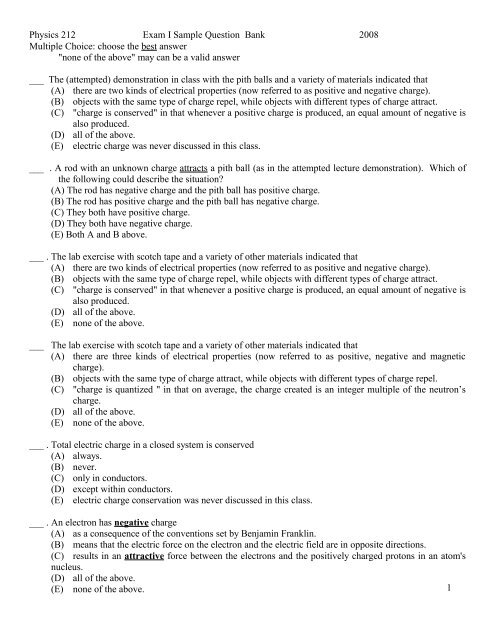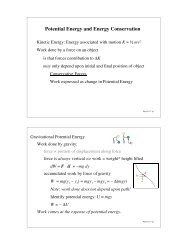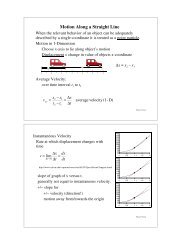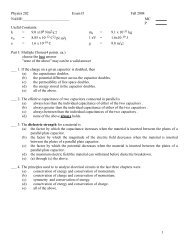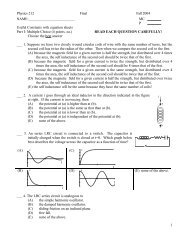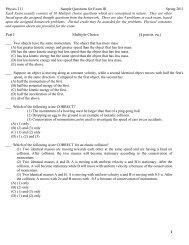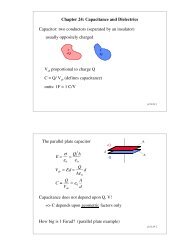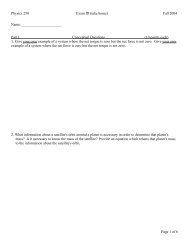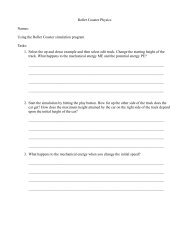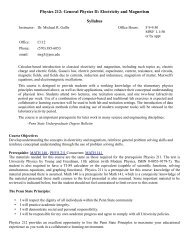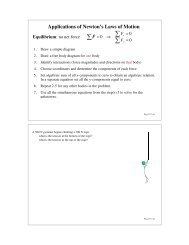Physics 212 Exam I Sample Question Bank 2008 Multiple Choice ...
Physics 212 Exam I Sample Question Bank 2008 Multiple Choice ...
Physics 212 Exam I Sample Question Bank 2008 Multiple Choice ...
Create successful ePaper yourself
Turn your PDF publications into a flip-book with our unique Google optimized e-Paper software.
<strong>Physics</strong> <strong>212</strong> <strong>Exam</strong> I <strong>Sample</strong> <strong>Question</strong> <strong>Bank</strong> <strong>2008</strong><strong>Multiple</strong> <strong>Choice</strong>: choose the best answer"none of the above" may can be a valid answer___ The (attempted) demonstration in class with the pith balls and a variety of materials indicated that(A) there are two kinds of electrical properties (now referred to as positive and negative charge).(B) objects with the same type of charge repel, while objects with different types of charge attract.(C) "charge is conserved" in that whenever a positive charge is produced, an equal amount of negative isalso produced.(D) all of the above.(E) electric charge was never discussed in this class.___ . A rod with an unknown charge attracts a pith ball (as in the attempted lecture demonstration). Which ofthe following could describe the situation?(A) The rod has negative charge and the pith ball has positive charge.(B) The rod has positive charge and the pith ball has negative charge.(C) They both have positive charge.(D) They both have negative charge.(E) Both A and B above.___ . The lab exercise with scotch tape and a variety of other materials indicated that(A) there are two kinds of electrical properties (now referred to as positive and negative charge).(B) objects with the same type of charge repel, while objects with different types of charge attract.(C) "charge is conserved" in that whenever a positive charge is produced, an equal amount of negative isalso produced.(D) all of the above.(E) none of the above.___ The lab exercise with scotch tape and a variety of other materials indicated that(A) there are three kinds of electrical properties (now referred to as positive, negative and magneticcharge).(B) objects with the same type of charge attract, while objects with different types of charge repel.(C) "charge is quantized " in that on average, the charge created is an integer multiple of the neutron’scharge.(D) all of the above.(E) none of the above.___ . Total electric charge in a closed system is conserved(A) always.(B) never.(C) only in conductors.(D) except within conductors.(E) electric charge conservation was never discussed in this class.___ . An electron has negative charge(A) as a consequence of the conventions set by Benjamin Franklin.(B) means that the electric force on the electron and the electric field are in opposite directions.(C) results in an attractive force between the electrons and the positively charged protons in an atom'snucleus.(D) all of the above.(E) none of the above. 1
<strong>Physics</strong> <strong>212</strong> <strong>Exam</strong> I <strong>Sample</strong> <strong>Question</strong> <strong>Bank</strong> <strong>2008</strong>___ . An electron has negative charge(A) as a consequence of the conventions set by Thomas Jefferson.(B) means that the electric force on the electron and the electric field are in oppositedirections.(C) results in an repulsive force between the electrons and the positively chargedprotons in an atom's nucleus.(D) all of the above.(E) none of the above.___ . An electron has positive charge(A) as a consequence of the conventions set by Benjamin Franklin.(B) means that the electric force on the electron and the electric field are in opposite directions.(C) results in an attractive force between the electrons and the positively charged protons in an atom'snucleus.(D) all of the above.(E) trick question, an electron is has negative charge.___ Relative to the gravitational attraction between two protons, the electrostatic repulsion is(A) much larger.(B) about the same.(C) much smaller.(D) trick question since the gravitational force will be repulsive, not attractive.(E) zero between the same kinds of particles.___ The electrostatic repulsion between two electrons is(A) much greater than the gravitational attraction between the electrons.(B) about the same as the gravitational attraction between the electrons.(C) much less than the gravitational attraction between the electrons.(D) the answer to this depends upon the actual separation between the electrons.(E) trick question since there is no gravitational attraction between electrons.___. As two positive charges are brought closer together(A) the repulsive force between them will decrease in magnitude.(B) the repulsive force between them will increase in magnitude.(C) the attractive force between them will decrease in magnitude.(D) the attractive force between them will increase in magnitude.(E) trick question since the force does not depend upon the separation between the charges.___ . Two identical charges repel each other with a force of 16N. If the distance between the charges isdoubled, the force will be(A) 1N.(B) 2N.(C) 8N.(D) 16N.(E) none of the above.
<strong>Physics</strong> <strong>212</strong> <strong>Exam</strong> I <strong>Sample</strong> <strong>Question</strong> <strong>Bank</strong> <strong>2008</strong>___ . Two unequally charged pellets are held apart at a fixed distance. The charge on one of the pellets ishalved, and the charge on the other is doubled. The electric force one pellet exerts on the other(A) will double.(B) will be halved.(C) will not change.(D) will increase by a factor of 4.(E) will decrease by a factor of 1/4.___ . Two unequally charged pellets are held apart at a particular distance. The charge on both of the pellets isdoubled, and the distance between the charges is also doubled. The electric force one pellet exerts on theother(A) will double.(B) will be halved.(C) will not change.(D) will increase by a factor of 4.(E) will decrease by a factor of 1/4.___ . Two identical charges repel each other with a force of 4N. If the distance between the charges is halved,the force will be(A) 1N.(B) 2N.(C) 8N.(D) 16N.(E) none of the above.___ . A positive charge of 4.0 µC exerts an attractive force of 8N on an unknown charge 20 cm away. Theunknown charge is(A) + 8.9 µC .(B) - 8.9 µC .(C) + 44. µC .(D) - 44. µC .(E) none of the above.___ . What must be the charge of a particle of mass 1kg for it to be levitated in a 1000 N/C downward directedelectric field?(A) + 9.8 µC.(B) - 9.8 µC.(C) + 9.8 nC.(D) - 9.8 nC.(E) none of the above.___ . In a static situation, if there is excess charge on a conductor then(A) the charge lies only on the surface of the conductor.(B) the charge is in constant motion throughout the conductor.(C) the charge evaporates from the conductor until there is no more excess charge.(D) the charge lies at the geometric center of the conductor.(E) the conductor explodes violently.
<strong>Physics</strong> <strong>212</strong> <strong>Exam</strong> I <strong>Sample</strong> <strong>Question</strong> <strong>Bank</strong> <strong>2008</strong>___ . A conductor is a material in which, under static conditions,(A) there are charges which are free to move.(B) the electric field is always zero.(C) the electric potential is always constant.(D) all of the above.(E) none of the above.___ . A conductor is a material in which, under static conditions,(A) there are charges which are free to move.(B) the electric field is always zero.(C) the electric potential is same throughout.(D) all of the above.(E) none of the above.___ . A rectangular area is oriented in a uniform Electric field directed left to right in the geometries shownbelow. Which geometry results in the greatest electric flux through the area?(A)AE(B)AE(C)AE(D)AE(E)the flux is the same in all these cases..___ . A rectangular area is oriented in a uniform Electric field directed left to right in the four geometries shownbelow. Rand the four scenarios from greatest flux to least flux.AAEE(1) (2)AAE(3) (4)E(A) Φ 1 = Φ 2 = Φ 3 = Φ 4(B) Φ 1 > Φ 2 > Φ 3 > Φ 4(C) Φ 4 > Φ 3 > Φ 2 > Φ 1(D) Φ 1 = Φ 4 > Φ 2 = Φ 3(E) Φ 2 = Φ 3 > Φ 1 = Φ 4
<strong>Physics</strong> <strong>212</strong> <strong>Exam</strong> I <strong>Sample</strong> <strong>Question</strong> <strong>Bank</strong> <strong>2008</strong>___. A perfectly spherical gaussian surface has a point charge of Q exactly at its geometric center.The electric flux through the spherical gaussian surface is(A) Q/ε o .(B) Q/2ε o .(C) Q/6ε o .(D) 0.(E) much more information is necessary to answer.___ . A perfectly cubical gaussian surface has a point charge of Q exactly at its geometriccenter. The Electric flux through one of the six faces of the cube is(A) Q/ε o .(B) Q/2ε o .(C) Q/6ε o .(D) 0.(E) much more information is necessary to answer.____ . A perfectly cubical gaussian surface has an electric dipole (two charges (±Q ) of equalsize put opposite signs separated by a distance l ) at its geometric center. The totalElectric flux through all of the six faces of the cube is(A) 2Q/ε o .(B) Q/2ε o .(C) Q/3ε o .(D) 0.(E) much more information is necessary to answer.___ . A perfectly spherical gaussian surface has a point charge of Q exactly at its geometriccenter. The electric flux through the bottom hemisphere (half-sphere) of the gaussiansurface is(A) Q/ε o .(B) Q/2ε o .(C) Q/6ε o .(D) 0.(E) much more information is necessary to answer.___ . A perfectly spherical gaussian surface has a an electric dipole (two charges (±Q ) of equalsize but opposite signs separated by a distance l ) at its geometric center. The totalElectric flux through the gaussian surface is(A) Q/ε o .(B) Q/2ε o .(C) Q/6ε o .(D) 0.(E) much more information is necessary to answer.
<strong>Physics</strong> <strong>212</strong> <strong>Exam</strong> I <strong>Sample</strong> <strong>Question</strong> <strong>Bank</strong> <strong>2008</strong>___. A perfectly cubical gaussian surface has a point charge of Q exactly at its geometric center. The Electricflux through one of the six faces of the cube is(A) Q/ε o .(B) Q/2ε o .(C) Q/6ε o .(D) 0.(E) much more information is necessary to answer.___. The electric field lines at a certain location(A) are parallel to the electric force on a test charge placed at that location.(B) are to perpendicular lines (surfaces) of constant electric potential at that location.(C) never cross.(D) start on positive charges and end on negative charges.(E) all of the above.___ . The electric field lines at a certain location(A) only cross at the location of magnetic monopoles.(B) are parallel to the electric force on a test charge placed at that location.(C) are parallel to lines (surfaces) of constant electric potential at that location.(D) start on positive charges and end on negative charges.(E) all of the above.___ . The electric field lines at a certain location(A) never cross.(B) are parallel to the electric force on a test charge placed at that location.(C) are perpendicular to lines (surfaces) of constant electric potential at that location.(D) start on positive charges and end on negative charges.(E) all of the above.___. Gauss's law(A) relates the total electric flux through a closed surface with the net electric charge enclosed within thesurface.(B) is completely equivalent to the inverse square law for the electric field due to a point charge.(C) implies that in static situations any excess charge on a conductor must lie on its surface.(D) is very useful for charge configurations with symmetry.(E) all of the above.___ . Gauss's law tells us that(A) if the net charge within a spherical surface is zero, then the electric field is zero.(B) if the electric flux through a spherical surface is zero, then there is no charge within thesphere.(C) if the electric flux through a spherical surface is zero, then the net charge within thesphere is zero.(D) Coulomb's law is wrong.(E) we can know absolutely nothing about charge contained within a spherical surface.
<strong>Physics</strong> <strong>212</strong> <strong>Exam</strong> I <strong>Sample</strong> <strong>Question</strong> <strong>Bank</strong> <strong>2008</strong>___ . In a static situation, if there is excess charge on a conductor then(A) the charge lies only on the surface of the conductor.(B) the charge is in constant motion throughout the conductor.(C) the charge evaporates from the conductor until there is no more excess charge.(D) the charge lies at the geometric center of the conductor.(E) the conductor explodes violently.___ . Identify the most correct statement(A) Gauss’s law is equivalent to Coulomb’s law.(B) Coulomb’s law is equivalent to Gauss’s law.(C) Gauss’s law is equivalent to Coulomb’s law only in situations with symmetry.(D) both (A) and (B).(E) Gauss’s law and Coulomb’s law are completely unrelated.___ . The electric field has magnitude 1000 N/C between parallel conducting plates separated by 5 mm (.005m).The potential difference between the plates is(A) 5V(B) 200V.(C) 5,000V.(D) 200,000V.(E) none of the above.___. The electric field is directed(A) away from areas with low electrical potential towards areas with higher electrical potential.(B) away from areas with high electrical potential towards areas with lower electrical potential.(C) along paths of constant electric potential.(D) along spirals.(E) electric fields are scalar quantities, and thus have no direction associated with them.___. The electric field magnitude near (but outside of) an irregularly shaped conductor(A) will be greatest where the surface has the sharpest curvature.(B) will be greatest where the surface has the flattest curvature.(C) does not depend upon the shape of the conductor.(D) will necessarily be zero.(E) trick question; since the electric field is a scalar quantity, the term “electric field magnitude” ismeaningless.___ . The electric potential is(A) is potential energy per unit charge.(B) is electrical force per unit charge.(C) is simply electrical energy.(D) is simply electrical charge.(E) always zero within conductors.
<strong>Physics</strong> <strong>212</strong> <strong>Exam</strong> I <strong>Sample</strong> <strong>Question</strong> <strong>Bank</strong> <strong>2008</strong>___ . The electric potential is(A) is simply electrical energy.(B) is simply electrical charge.(C) is potential energy per unit charge.(D) is electrical force per unit charge.(E) always zero within conductors.___ . The figure below depicts electric field lines. For the points A, B and C in figure, which of the choicesbelow corresponds to the ranking of the electric field magnitude from strongest to weakest:(A) E AE B E C(B) E CE BE AA(C) E A=E B= E C(D) E A=E B E BC(E) the figure does not provide enough information.C___. Which of the following is a physically possible scenario?(A) Two different equipotential surfaces (lines of constant voltage) cross.(B) Two different electric field lines cross.(C) An electric field line crosses an equipotential surface at 90°.(D) All of the above(E) None of the above.
<strong>Physics</strong> <strong>212</strong> <strong>Exam</strong> I <strong>Sample</strong> <strong>Question</strong> <strong>Bank</strong> <strong>2008</strong>Short <strong>Question</strong>sWhat are the qualitative similarities and differences between Coulomb's Law and Newton's Law of UniversalGravitation. (be brief and specific)Describe what happens to an uncharged conductor when a positive charge is brought near. Explain any forcesthat are exerted on the conductor. A sketch or drawing may be helpful.Describe what happens to an uncharged insulator when a positive charge is brought near. Explain any (net)forces that are exerted on the insulator. A sketch or drawing may be helpful.Draw the electric field lines for the two conductors below (the total charges on each conductor are the equal butopposite)+− − − − −Draw the electric field lines for the two conductors below (the total charges on each conductor are the equal butopposite)+ + + + +− − − − −Draw the electric field lines for the charge configuration below (the total charges on each object are the sameand both are positive)++
<strong>Physics</strong> <strong>212</strong> <strong>Exam</strong> I <strong>Sample</strong> <strong>Question</strong> <strong>Bank</strong> <strong>2008</strong>Problems: Show all work. No work = no credit!Two small spheres spaced 75 cm apart have equal charge. How many excess electrons must be present on eachsphere if the magnitude of the repulsive force between them is 1.47456E-22 N?A +100 µC charge (Q 1 ) is placed at x = 0 m, y = 2 m. A +400µC charge (Q 2 ) is placed (2m,0m)).(A) Determine the point on the x axis where the net electric field will be zero.(B) What is the electric force on a 250 µC charge place at this location?(C) What is the electric potential energy on a 250 µC charge place at this location due to the two sourcecharges?Three source charges are placed asshown. Q 1 is located at (0,4m) and has acharge of +81µC. Q 2 is located at (0,0)and has a charge of +125µC. Q 3 islocated at (3m, 0) and has a charge of−64µC.a) Calculate the Electric Field (x and ycomponents) at the point (3m, 4m).b) Calculate the electric potential at thepoint (3m, 4m).A test charge of 30 µC is placed at thepoint (3m, 4m).c) What is the force on this charge?d) What is its (electrostatic) potentialenergy?Q1Q2Q3A +200 µC charge (Q 1 ) is placed at x = 0 m, y = 2 m. A −200µC charge (Q 2 ) is placed (2m,2m)). A charge of+400µC charge (q) is located at (2m,2m).(A) What are the components of the electric field at the location of q due to the other two charges ? (q willeffectively be the "test charge")(B) What are the components the force on q?(C) What is the electrostatic potential at the location of q due to the other two charges ?(D) What is the potential energy of q due to the presence of the other two charges?
<strong>Physics</strong> <strong>212</strong> <strong>Exam</strong> I <strong>Sample</strong> <strong>Question</strong> <strong>Bank</strong> <strong>2008</strong>Q 1qQ 2Three charges are placed as shown at right,Q 1 = −64 µC at (0,3m),Q 2 = 125 µC at (0,0), andQ 3 = 27 µC at (4m,0),(A) Determine the x and y components of theelectric field at the location (4m,3m).(B) Determine the x and y components of electricforce on a charge q = 30 µC placed at the point(4m,3m).Q 13m4mQ2Q 3Three source charges are placed at thecorners of an equilateral triangle 2m on aside, as shown. Q 1 and Q 2 are located onthe base corners, and have a charge of+10µC each. Q 2 is located at top cornerand has a charge of -10µC. a) Calculatethe Electric Field (x and y components)at the point at the center of the triangle.b) Calculate the electric potential at thepoint at the center of the triangle.Q3A test charge of 30 µC is placed at thepoint at the center of the triangle.c) What is the force on this charge?d) What is its (electrostatic) potentialenergy?Q1Q2An electron gun accelerates electrons across a potential difference of 30.0 kV. The beam is fired horizontallybetween to charged conducting plates in order to deflect the beam vertically. The deflecting plates are 2.00 cm
<strong>Physics</strong> <strong>212</strong> <strong>Exam</strong> I <strong>Sample</strong> <strong>Question</strong> <strong>Bank</strong> <strong>2008</strong>long, separated by 1.00 cm and have a potential difference of 2.00kV.a) What is the speed of the electrons as they leave the accelerating potential?b) What is the electric field between the deflecting plates?c) What is the electric force on the electrons?d) How long are the electrons between the plates? (time, in seconds)e) What is the vertical component of velocity as the electrons leave the deflecting plates?f) What is the final direction of the electron beam? (i.e. direction of final electron velocity)A proton (q=+e, m=1.66x10 -27 kg) is accelerated from rest across a potential difference of 20kV.a) What is the kinetic energy (in electron volts) of the proton as it leaves the accelerator?b) What is this energy in Joules?c) What is the speed of the proton ?The proton now reaches a region with a uniform electric field produced by parallel conducting platesseparated by 1cm with a potential difference of 2000V between them, producing a upward directed electric fieldwhich extends 5 cm in the horizontal direction.d) What is the electric field magnitude in the region between the plates?e) How long is the proton in this region?f) What is the acceleration of the proton while in this region?g) What are the x and y components of velocity of the proton as it leaves the region?5 cm"proton" gunpEA line of charge Q lies on the y axis and extends from −a. to +a. (total length of 2a ). We wish to derive anexpression for the electric field for a point on the x-axis. From the symmetry of the configuration, the netElectric field along the x-axis should only have an x component. A typical point is indicated on the diagrambelow. We will consider the contributions of each (infinitesimal) section of the line of charge of where thelength of the segment is dy.a) Determine the charge per unit length λ .b) Determine the charge of a piece of length dy.(for c-f express all geometric factors in terms of x and y only!)c) Determine the distance from the piece of charge to the field point.d) Determine the magnitude of the electric field due to this piece.e) Determine the x component of the electric field due to this piece.f) Since the contribution to the x component of the electric field will be the same for every such section of thering, set up but do not evaluate the integral which will add up all such components to find the net component ofthe electric (i.e. add up all contributions along the axis, dy at a time, to account for the length of charge).
<strong>Physics</strong> <strong>212</strong> <strong>Exam</strong> I <strong>Sample</strong> <strong>Question</strong> <strong>Bank</strong> <strong>2008</strong>+ adyyPxE xE− aTwo oppositely charged point charges +/- q lie on the y axis at +a and -a as shown. Express ALL answers interms of x, a, q and k.a) What is the magnitude of the electric field +qcontribution from the top charge?y=aIndicate the direction of this contributionon the diagram.ac) What is the x-component of this contribution tothe electreic field?d) What is the y-component of this contribution tothe electreic field?xe) What is the magnitude of the electric fieldcontribution from the bottom charge?fieldpointIndicate the direction of this contributionon the diagram.f) Indicate the direction of this contribution on the -qdiagram below.y=-ag) What is the x-component of this contributionto the electreic field?h) What is the y-component of this contribution tothe electreic field?i) What is the net x-component?j) What is the net y-component?k) sketch a graph of the net y componentA ring of of charge Q lies in the y-z plane and has a radius of a. We wish to derive an expression for theelectric field for a point on the x-axis. From the symetry of the configuration, the net Electric field along the xaxis should only have an x component. A typical point is indicated on the diagram below. We will consider thecontributions of each (infinitesimal) section of the ring of charge of where the length of the segment is ds.a) What is the charge per unit length λ?b) What is the charge of a piece of length ds.(for c-e express all geometric factors in terms of x and a only!)c) What is the distance from the piece of charge to the field point?d) What is the magnitude of the electric field due to this piece?e) What is the x component of the electric field due to this piece?
<strong>Physics</strong> <strong>212</strong> <strong>Exam</strong> I <strong>Sample</strong> <strong>Question</strong> <strong>Bank</strong> <strong>2008</strong>f) Since the contribution to the x component of the electric field will be the same for every such section of thering, by inspection add up all such components to find the net component of the electric (i.e. add up allcontributions along ds to account for the entire circumference of the ring).dsaPxE xEA long coaxial cable consists of an inner cylindrical conductor with a radius a andan outer concentric cylinder with inner radius b and outer radius c. The innercylinder has a charge per unit length λ, and the outer cylinder has no net charge.(A) Give an expression for the electric field magnitude in terms of the distance rfrom the center of the spheres for the following regions:r < aa < r < bb < r < cc< r(B) Draw a graph of the electric field magnitude for 0 < r < 2c(C) What is the charge per unit length on the inner surface of the hollow sphere?(D) What is the charge per unit length on the outer surface of the hollow sphere?bqE(r)aqcqa b crqA solid conducting sphere of radius a carries a charge q. It is inside a concentric hollowconducting sphere of inner radius b and outer radius c. The outer sphere carries a netcharge of –q.(A) Give an expression for the electric field in terms of the distance r from the center ofthe spheres for the following regions:r < aa < r < bb < r < cc < rE(r)(B) Draw a graph of the electric field magnitude for 0 < r < 2c(C) What is the charge on the inner surface of the hollow field?(D) What is the charge on the outer surface of the hollow field?(E) Using your expression for E(r) for the region a < r < b , determineV ab by evaluating the final term inbb Vab= ∫ E ⋅ dl = ∫ E ( r)dra b caaa bcr
<strong>Physics</strong> <strong>212</strong> <strong>Exam</strong> I <strong>Sample</strong> <strong>Question</strong> <strong>Bank</strong> <strong>2008</strong>An infinitely long solid conducting cylinder of radius a carries a charge perunit length λ. It is inside a concentric hollow conducting cylinder of innerradius b and outer radius c. The outer cylinder carries a net charge per unitlength of –λ.(A) Give an expression for the electric field in terms of the distance r from thecenter of the cylinder for the following regions:abcr < aa < r < bb < r < cc < rE(r)(B) Draw a graph of the electric field magnitude for 0 < r < 2c(C) What is the charge on the inner surface of the hollow field?(D) What is the charge on the outer surface of the hollow field?(E) Using your expression for E(r) for the region a < r < b , determineV ab by evaluating the final term inbb Vab= ∫ E ⋅ dl = ∫ E(r)draaa b crAn proton is accelerated from rest across a potential difference of 10 million Volts.a) What is the kinetic energy (in Joules) of the proton as it leaves the accelerator?b) What is the speed of the proton?The proton now makes a head on “collision” (approaching from “very far away”) with a gold nucleus(which has atomic number 79, and hence a charge of +79e). Assume the nucleus is stationary for thisproblem.c) What is the speed of the proton at the turn around point?d) What is the kinetic energy of the proton at the turn around point?e) What is the potential energy of the proton at the turn around point?f) What is the distance between the proton and the nucleus at the turn around point?protonproton accelerator +e +79egold nucleus


